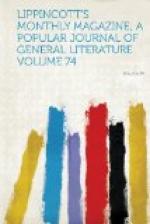Ten years after our farewell to Sister Maria Colomba behind the bars of the convent-parlor we saw her again, and, armed with a papal permission, were shown by her over the whole convent. Those rare occasions when a stranger is allowed to penetrate the “enclosure” are always gala-days for the nuns. I remarked the blithe, youthful look that shone on all their faces: Sister Maria Colomba herself, from a pale, nervous girl, had expanded into a strong, hale, buxom woman. The glow of health was on her cheek, the sparkle of innocent mirth shone in her eye. There was one among the sisters who gleefully asked me to guess at her age. She was a sweet, fresh-complexioned, matronly woman. “Not more than fifty, good mother,” was the answer.
She laughed and gently clapped her hands. “Add twenty years to that,” she answered with an innocent burst of pride. Then she told how she had entered the order while yet in her “teens,” had held half the offices of trust in the community, and had never missed any of the most rigid fasts or absented herself once from the midnight office, never having known so much as a day’s ill-health. “Ah, a nun’s life is a healthy one, child, as well as a happy one,” she said in conclusion.
We went over the kitchen, laundry, refectory, dormitories, chapel, garden, etc. Just the same as before—a little “calvary” at one end of the garden and a rough picture of a Madonna in an arbor, the long, echoing corridors spotless as the deck of a man-of-war, and the smiling faces making a very flower-garden of the community-room. We left loaded with specimens of the nuns’ work—Agnus Deis in frames of silver filigree dotted with white roses and hanging from white satin ribbon-bows; flake-like biscuits of peculiar flavor; and baskets, pincushions, etc. of delicate workmanship. I do not know whether this convent is still in the hands of the Dominicanesses, so many in Rome having become barracks since the new royal authority superseded that of the pope. But the picture of San Domenico e Sisto as it was in 1853 and 1863 may yet interest many who perhaps will never have the opportunity of seeing such an establishment for themselves.




